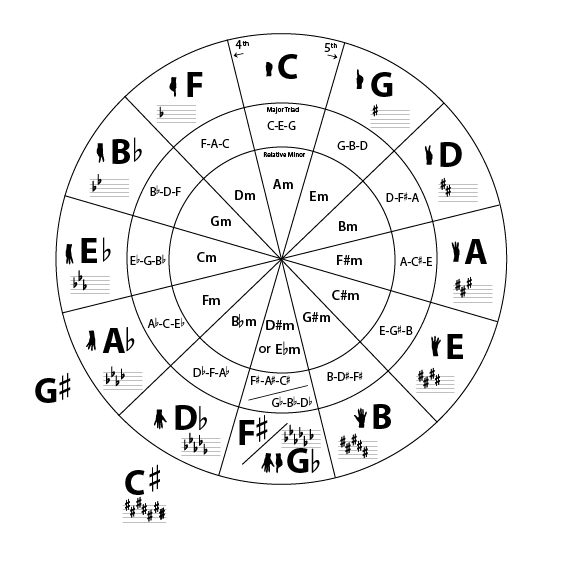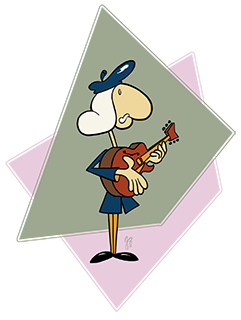The 2-5-1 turnaround moves in fourths, which is counter-clockwise on this chart. Many jazz songs either move in fourths or have a part of the song that does. This chart also includes the major triads which are essential to commit to memory.
I've also included the signature for the key in the staff. At the beginning of the staff, you will see a collection of sharps or flats (C major has no sharps or flats). The sharps and flats are the "key signature" -- indicating the key the song is in. For instance, if you see three sharps, that is the key of A major. Three sharps is also the key symbol for F# minor; the companion minor of A major is F# minor. The companion minor keys are on the inner circle of this chart.
What about those jazz hands? In a session, the leader might call out a tune and need to signal it's in E major, since songs can be played in different keys. Since "E" sounds a lot like "B" and "C" and "D", confusion is avoided by holding fingers up for sharps and down for flats. If a bandleader holds two fingers up, that means the song will be in the key of D major, or (B minor, if it's a minor tune).
You will notice that the number of sharps increase by one with each move clockwise and the flats increase with each move counter-clockwise until you reach the bottom. There are two mnemonic devices to memorize how the flats and sharps progress, but guess what? The progression also moves like the cirlce!
The mnemonic phrase for sharps is: Fine Classical Guitarists Demand Accurate Execution (Buddy). Congratulations, you just learned the clockwise progression of the circle! The sharps are added in fifths. The key of G has 1 sharp: C. The key of D has two sharps, C and G. The sharps keep adding as you advance.
The flats are added in fourths. The mnemonic phrase for flats is: Be Ever Alert During Guitar Class (Forever). The key of F has the one flat of B. The key of B flat has the flats of B and E in the signature. This signature adds a flat as you go counter-clockwise in the circle, advancing in fourths. This progression is the reverse of the sharps, alphabetically.
It is wise to learn all the key signatures. If you see a lead sheet and are uncertain, there are two tricks to help you out. For key signatures with sharps, if you look at the note above the last sharp, that is the key. The signature for G is the sharp of F. Move one up from F and you get the key -- G. For flats, the key is the second-to-last flat. The key Ab major has four flats in the signature, B, E, A, D. Move back one from the last flat on the signature (sitting on the D). The penultimate flat sits on the A -- therefore, the tune is in A flat.
That's all I know about the circle for now, but you can see the circle's usefulness. This is a good reference for things to learn -- key signatures, 2-5-1 progressions, companion minors, major triads, etc.
When I first tried to learn the progression, my mnemonic was BEAD, Guitars Cause Fun. If that doesn't stick, make up your own -- the weirder the better. Or use "Be Ever Alert During Guitar Class Forever." It's also good to know the alphabet starts over at F (going to flats) and F#, going to naturals. F is for "flip" in this case. Of course all the sharps have an identical flat and vice versa (F# is Gb), so be aware of that.
| circleoffifths.pdf |


 RSS Feed
RSS Feed
